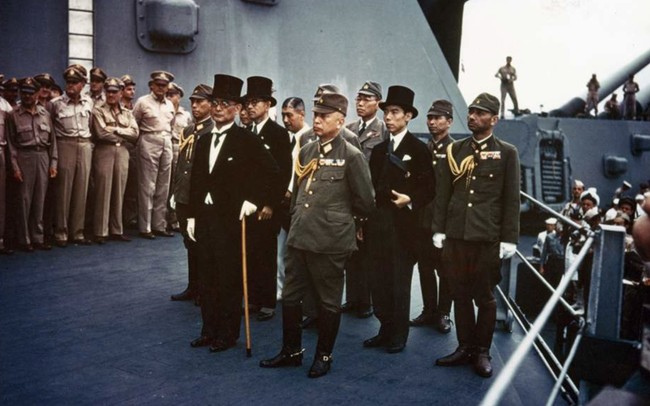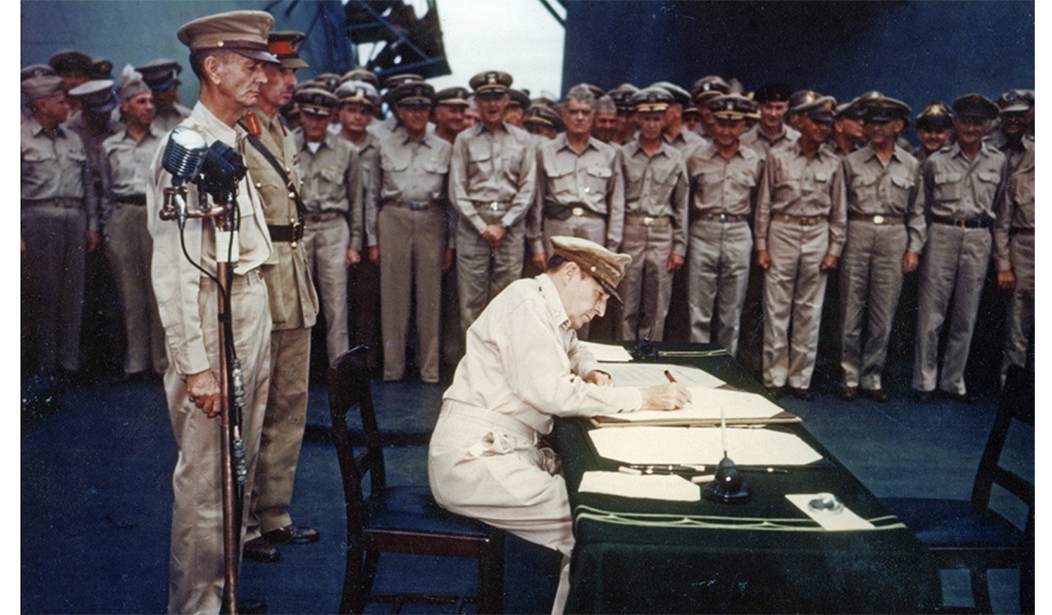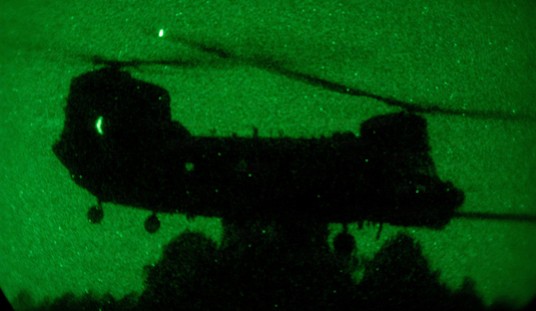The surrender of Germany, or at least the signing of the surrender documents, was distinctly anticlimactic. It took place at 2:41 a.m., in a bare and poorly lit red schoolhouse in Reims, France. It was Dwight Eisenhower’s forward headquarters.
Lt. Gen. Walter Beddel Smith signed for Eisenhower, the Supreme Commander of the Allied Forces. Ike didn’t attend. He didn’t want a spectacle. He wanted just the opposite of a “Hollywood” ending. The war in the Pacific was still raging.
Two atomic bombs finally put an end to the Emperor's resistance. He and his country, Japan, capitulated. The formal surrender was yet to come. The Supreme Commander in the Pacific was Douglas MacArthur, who was steeped in tradition and well-versed in military lore. He intended the surrender of Japan to be a spectacle befitting of Hollywood and, of course, Douglas MacArthur.
Indeed there were, at a minimum, 245 journalists and 75 photographers present.
MacArthur intended for the Japanese to surrender in public, under the sun in the deep gaze of a thousand common sailors, soldiers, and Marines and dozens of generals, admirals, and dignitaries.
That last battleship built and commissioned would be the location. The Mighty Mo. The USS Missouri. The Missouri wasn't anchored in front of Tokyo and in view of the Imperial Palace, rather it was miles away – south of the city. She anchored in the same spot as Admiral Perry anchored almost a hundred years before when Perry made Japan open up to US merchant ships. Perry’s flag was flown in from Annapolis. It wasn’t flying – it was under glass, on the starboard bulkhead. Symbolism was paramount to MacArthur.
The 45,000-ton battleship was scrubbed spotless. The British supplied a mahogany table for the signing, but it was undersized for the event. The specially prepared leather and gold embossed portfolios simply wouldn’t fit on the tiny table. Navy officers and sailors improvised. They unscrewed a mess table from the enlisted mess and brought it topside. The green tablecloth covering the drab steel table wasn’t spotless, but it would have to do.
Destroyers were running as waterborne taxis shuttling VIPs to the battlewagon. The time for the Japanese to step onto the Missouri was planned down to the second. Even the amount of time it would take the delegation to traverse the distance was timed out. Foreign Minister Mamoru Shigemitsu had a false leg - a wooden leg, so Missouri officers had a sailor walk with a sawed-off broomstick against his straight leg to simulate Shigemitsu’s addled steps leading to the veranda deck.

The signing for MacArthur was planned for precisely 9:08 a.m. More symbolism. He had planned for hundreds of US warplanes, fighters, bombers, and every other conceivable warplane to cast their shadows across the Missouri as MacArthur signed and the Japanese watched and looked up at warplanes darkening the skies.
This was Macarthur’s version of passing under the yoke. In ancient Rome, Roman legions would have bound and defeated enemies pass under an oxen yoke to humiliate the enemy.
MacArthur’s “yoke” would be hundreds of warplanes. The Japanese would be passing under a sky of warplanes. His intent was to send a message to the Japanese but also to the rest of the world. The USA was the big dog on the block now. But the planes weren’t there.
The warplanes were late. 17 minutes later, at 9:25 A.M, MacArthur reluctantly said to the assembled officials and warfighters:
“These proceedings are now closed.” MacArthur then found Admiral “Bull” Halsey’s and said “Bill, where the hell are those airplanes?”
MacArthur described what happened next in his autobiography.
“At that moment, the skies parted and the sun shone brightly through the layers of clouds. There was a steady drone above and now it became a deafening roar and an armada of airplanes paraded into sight, sweeping over the warships…. It was over.”
78 years ago, World War II ended. My dad was on shore at Yokosuka Naval Base as part of the occupation force. He couldn’t see the Missouri from where he was but he knew the war was officially at an end – he could hear the “Wooop, Wooop, Woopp from the ships in the harbor.














Join the conversation as a VIP Member